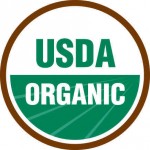What was I thinking? I was trying to throw together a quick brown-bag lunch on this first day of the Food for Change Challenge, and I discovered I already was messing up.
 Breakfast was OK. I had 100% organic cereal (so far, high-fructose corn syrup doesn’t qualify as organic) with Iwig milk, coffee, orange juice. Note: If a food is “made with organic ingredients” it could contain HFCS. (Here are the USDA organic labeling standards, a PDF.)
Breakfast was OK. I had 100% organic cereal (so far, high-fructose corn syrup doesn’t qualify as organic) with Iwig milk, coffee, orange juice. Note: If a food is “made with organic ingredients” it could contain HFCS. (Here are the USDA organic labeling standards, a PDF.)
As I was scooping a portion of Anderson-Erickson Old-Fashioned Cottage Cheese into a container for lunch (along with my local tomato, local bread, leftover local peach dessert (more on it later) and more Iwig milk) when it occurred to me that although A-E doesn’t use milk from cows treated with rBGH or rBST (read about it at Sustainable Table), it’s probably still fairly intensively produced, even if relatively local. Plus, the ingredients list was discouraging:
Cultured Grade A Pasteurized Fat Free Skim Milk, Milk, Cream, Salt, Guar Gum, Mono And Diglycerides, Xanthan Gum, And Locust Bean Gum.
The Center for Science in the Public Interest’s helpful food additives list gives some insights. The guar, xanthan and locust bean gums stood out. According to CSPI, they are “derived from natural sources (bushes, trees, seaweed, bacteria) and are poorly tested, though probably safe…. They are used to thicken foods…” Then there’s the mono and diglycerides. CSPI says they’re emulsifiers and are safe.
Not exactly what Granny would have used, and I’m going to count the cottage cheese as a relatively minor slip. But if I’m going to eat Food for Change, I’d better find a more local source for my cottage cheese or make it myself from local milk. Here’s Alton Brown’s cottage cheese recipe. It’s easy, and I don’t need to look up the ingredients: milk, cream, vinegar, salt. I even have those on hand! Then, if I get ambitious, I can save the leftover whey and try the uses for it discussed at Chowhound.
How’d your day go?


Jennifer // Aug 3, 2009 at 8:20 pm
Wow, you’re making your own cottage cheese? That’s ambitious! Be sure to post the results!
Bruce // Aug 4, 2009 at 11:05 am
Why to you state that the xanthan gum, guar gum, and locust bean gum are poorly tested? What is your basis for this statement??
Janet Majure // Aug 4, 2009 at 11:33 am
I haven’t yet, Jennifer. Stay tuned.
Bruce, that statement is a quote from the CSPI site. I took it at face value. I think CSPI is generally credible on such matters, but try the link and see for yourself.
Bruce // Aug 4, 2009 at 1:41 pm
Well, first off you hasve to be aware that neither guar gum, xanthan gum, nor locust bean gum are produced from seaweed. Stabilizers typically used in food production which are derived from seaweed are carrageenan, alginate, and agar. They’ve gotten this part wrong. In addition, I work for a multi-national company which produces xanthan gum, among other hydrocolloids, and can asure you that we employ strict testing procedures to comply with all relevant food safety standards. You should not make such generalizations. In addition, you should be aware that hydrocolloids, such as pectin, xanthan gum, carrageenan, and the like, make it possible to enjoy food products with a uniform texture and apperance and quality eating experience.
Jennifer // Aug 4, 2009 at 2:38 pm
Good to know big agribusiness is looking out for their monetary interests. How dare you malign such an innocent food product as xanthan gum Janet???
Janet Majure // Aug 4, 2009 at 8:01 pm
Relax, Bruce, and reread the information on the link.
And Jennifer, thanks for watching my back, even if I wasn’t really maligning xanthan gum! In the world of food additives it’s indeed pretty innocent, but it’s still an additive that seems not in the spirit of the challenge. :)
Bruce // Aug 4, 2009 at 11:43 pm
Next time do a little more homework before making such blanket statements as “poorly tested” Why do you feel that additives are so bad, the products which you reference, guar gum, xanthan gum, and locust bean gum all have their beginnings in nature.